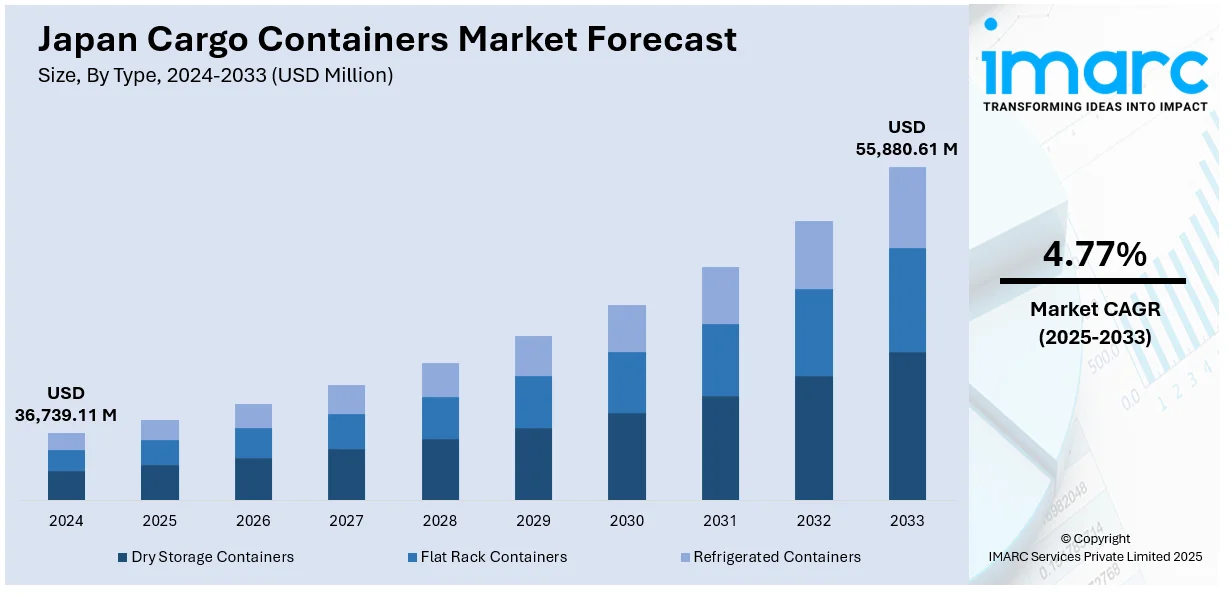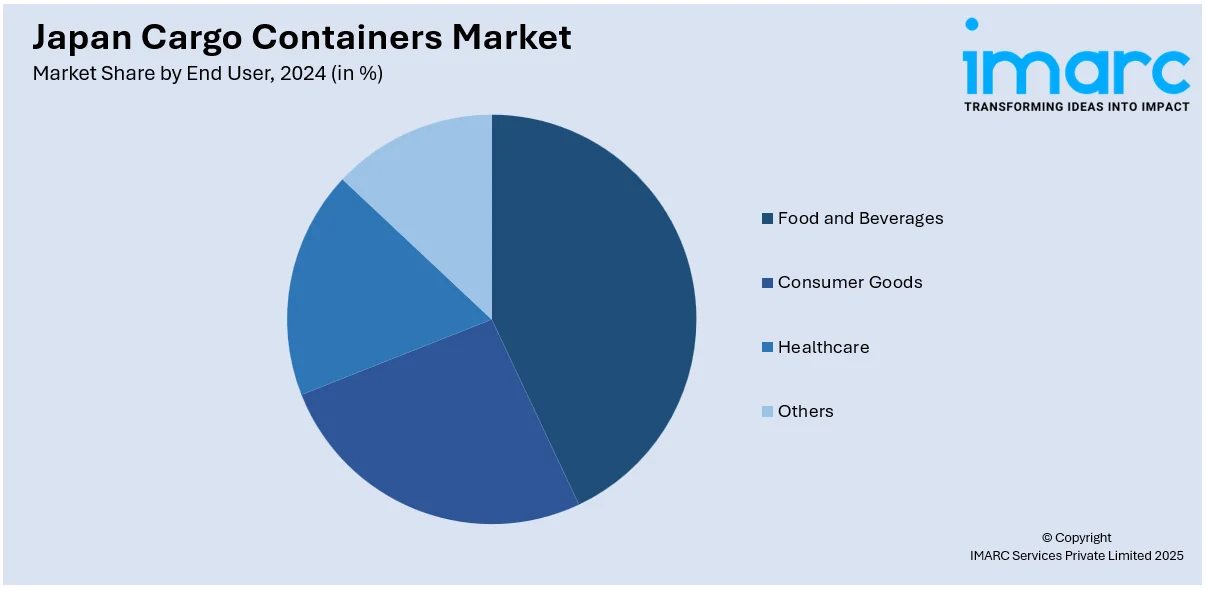
Japan Cargo Containers Market Size, Share, Trends and Forecast by Type, Size, End User, and Region, 2025-2033
Japan Cargo Containers Market Overview:
The Japan cargo containers market size reached USD 36,739.11 Million in 2024. Looking forward, IMARC Group expects the market to reach USD 55,880.61 Million by 2033, exhibiting a growth rate (CAGR) of 4.77% during 2025-2033. The industry is changing towards sustainability and greater logistics efficiency. Developments such as ice battery technology and upgraded air cargo services are fueling expansion. These developments are set to boost Japan cargo containers market share, thereby strengthening regional and global trade connections.
|
Report Attribute
|
Key Statistics
|
|---|---|
|
Base Year
|
2024
|
|
Forecast Years
|
2025-2033
|
|
Historical Years
|
2019-2024
|
| Market Size in 2024 | USD 36,739.11 Million |
| Market Forecast in 2033 | USD 55,880.61 Million |
| Market Growth Rate 2025-2033 | 4.77% |
Japan Cargo Containers Market Trends:
Sustainability and Eco-friendly Logistics Solutions
The growing trend in Japan's cargo containers industry is the shift towards sustainable and environmentally friendly logistics solutions. For instance, in June 2024, CONCOR partnered with ITE Japan to integrate ice battery technology into containers for temperature-sensitive cargo. This green technology reduces the use of diesel-based refrigeration, considerably lowering the environmental footprint of cold chain logistics. The ice battery technology also keeps temperature-sensitive items, like drugs and perishables, in cold storage for prolonged periods, hence making it a vital solution for eco-friendly enterprises. With the adoption of such technologies, Japan's logistics industry is poised to achieve global sustainability goals, increasing efficiency while decreasing environmental footprint. The success of this technology will serve as a precedent for other logistics players to emulate, making Japan more competitive in the global market through more sustainable and affordable logistics options. The inclusion of ice battery technology in containers represents a big step forward in revolutionizing the logistics industry in Japan, making the cold chain process cleaner and more dependable.

Enhanced Air Cargo Connectivity for Regional Trade
A prominent trend in Japan cargo containers market growth is the enhancement of air cargo services, specifically aimed at boosting regional trade and connectivity. For example, in August 2024, Yamato Holdings, Japan Airlines, and SPRING JAPAN launched dedicated cargo aircraft services between Tokyo's Haneda Airport and Sapporo/Kitakyushu. These freighters fly late at night, ensuring the rapid and efficient transportation of cargo even when passenger flights are not running. The night operation enables product delivery like agricultural and marine products with ease, ensuring they are delivered to remote areas without interfering with daytime production and harvesting times. This expansion of its air cargo operations strengthens Japan's logistical support infrastructure, aiding local industries and furthering trade growth. The capacity to provide quick, reliable air freight for domestic goods enhances Japanese cargo containers market efficiency and supply chain robustness. The project also increases the scope for international trade by providing regular, on-time air freight services, enhancing the overall efficiency of the market and satisfying the escalating demand for quick, trustworthy logistics solutions throughout Japan.
Japan Cargo Containers Market Segmentation:
IMARC Group provides an analysis of the key trends in each segment of the market, along with forecasts at the country and regional level for 2025-2033. Our report has categorized the market based on type, size, and end user.
Type Insights:
- Dry Storage Containers
- Flat Rack Containers
- Refrigerated Containers
The report has provided a detailed breakup and analysis of the market based on the type. This includes dry storage containers, flat rack containers, and refrigerated containers.
Size Insights:
- Small Containers (20 ft)
- Medium Containers (40 ft)
- Large Containers (Above 40 ft)
The report has provided a detailed breakup and analysis of the market based on the size. This includes small containers (20 ft), medium containers (40 ft), and large containers (above 40 ft).
End User Insights:

- Food and Beverages
- Consumer Goods
- Healthcare
- Others
A detailed breakup and analysis of the market based on the end user have also been provided in the report. This includes food and beverages, consumer goods, healthcare, and others.
Regional Insights:
- Kanto Region
- Kansai/Kinki Region
- Central/ Chubu Region
- Kyushu-Okinawa Region
- Tohoku Region
- Chugoku Region
- Hokkaido Region
- Shikoku Region
The report has also provided a comprehensive analysis of all the major regional markets, which include Kanto Region, Kansai/Kinki Region, Central/ Chubu Region, Kyushu-Okinawa Region, Tohoku Region, Chugoku Region, Hokkaido Region, and Shikoku Region.
Competitive Landscape:
The market research report has also provided a comprehensive analysis of the competitive landscape. Competitive analysis such as market structure, key player positioning, top winning strategies, competitive dashboard, and company evaluation quadrant has been covered in the report. Also, detailed profiles of all major companies have been provided.
Japan Cargo Containers Market News:
- May 2025: Nippon Express launched the "Vienna Consolidation" ocean freight service from Japan to Central and Eastern Europe. The service covers major Japanese ports and 26 destinations in Europe, offering cost-effective and high-quality transport solutions, thereby enhancing efficiency in the Japan cargo containers market.
- April 2025: Mitsubishi Logisnext delivered an advanced container terminal gate system to the Port of Osaka’s Yumeshima Terminal. Using 5G handheld terminals and AI-powered cameras, the system streamlined container entry/exit, enhancing efficiency and reducing congestion, positively impacting the Japan cargo containers market.
Japan Cargo Containers Market Report Coverage:
| Report Features | Details |
|---|---|
| Base Year of the Analysis | 2024 |
| Historical Period | 2019-2024 |
| Forecast Period | 2025-2033 |
| Units | Million USD |
| Scope of the Report |
Exploration of Historical Trends and Market Outlook, Industry Catalysts and Challenges, Segment-Wise Historical and Future Market Assessment:
|
| Types Covered | Dry Storage Containers, Flat Rack Containers, Refrigerated Containers |
| Sizes Covered | Small Containers (20 ft), Medium Containers (40 ft), Large Containers (Above 40 ft) |
| End Users Covered | Food and Beverages, Consumer Goods, Healthcare, Others |
| Regions Covered | Kanto Region, Kansai/Kinki Region, Central/ Chubu Region, Kyushu-Okinawa Region, Tohoku Region, Chugoku Region, Hokkaido Region, Shikoku Region |
| Customization Scope | 10% Free Customization |
| Post-Sale Analyst Support | 10-12 Weeks |
| Delivery Format | PDF and Excel through Email (We can also provide the editable version of the report in PPT/Word format on special request) |
Key Questions Answered in This Report:
- How has the Japan cargo containers market performed so far and how will it perform in the coming years?
- What is the breakup of the Japan cargo containers market on the basis of type?
- What is the breakup of the Japan cargo containers market on the basis of size?
- What is the breakup of the Japan cargo containers market on the basis of end user?
- What is the breakup of the Japan cargo containers market on the basis of region?
- What are the various stages in the value chain of the Japan cargo containers market?
- What are the key driving factors and challenges in the Japan cargo containers?
- What is the structure of the Japan cargo containers market and who are the key players?
- What is the degree of competition in the Japan cargo containers market?
Key Benefits for Stakeholders:
- IMARC’s industry report offers a comprehensive quantitative analysis of various market segments, historical and current market trends, market forecasts, and dynamics of the Japan cargo containers market from 2019-2033.
- The research report provides the latest information on the market drivers, challenges, and opportunities in the Japan cargo containers market.
- Porter's five forces analysis assist stakeholders in assessing the impact of new entrants, competitive rivalry, supplier power, buyer power, and the threat of substitution. It helps stakeholders to analyze the level of competition within the Japan cargo containers industry and its attractiveness.
- Competitive landscape allows stakeholders to understand their competitive environment and provides an insight into the current positions of key players in the market.
Need more help?
- Speak to our experienced analysts for insights on the current market scenarios.
- Include additional segments and countries to customize the report as per your requirement.
- Gain an unparalleled competitive advantage in your domain by understanding how to utilize the report and positively impacting your operations and revenue.
- For further assistance, please connect with our analysts.
 Request Customization
Request Customization
 Speak to an Analyst
Speak to an Analyst
 Request Brochure
Request Brochure
 Inquire Before Buying
Inquire Before Buying




.webp)




.webp)












